Nursing Assessments 2022
VerifiedAdded on 2022/10/11
|12
|2570
|8
Assignment
AI Summary
Contribute Materials
Your contribution can guide someone’s learning journey. Share your
documents today.

Running head: NURSING ASSESSMENTS 1
Nursing Assessments
Name of Author
Institution
Date of Submission
Nursing Assessments
Name of Author
Institution
Date of Submission
Secure Best Marks with AI Grader
Need help grading? Try our AI Grader for instant feedback on your assignments.
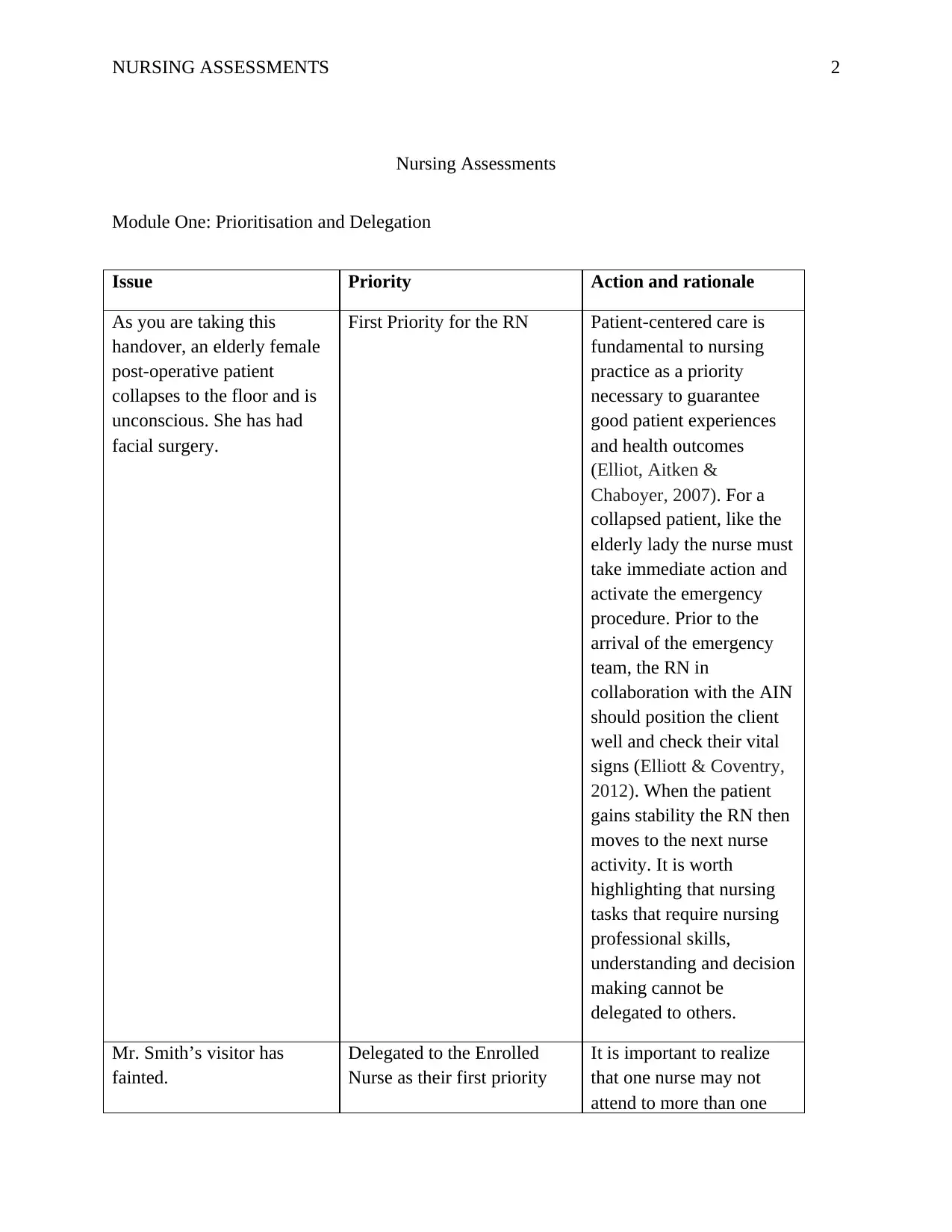
NURSING ASSESSMENTS 2
Nursing Assessments
Module One: Prioritisation and Delegation
Issue Priority Action and rationale
As you are taking this
handover, an elderly female
post-operative patient
collapses to the floor and is
unconscious. She has had
facial surgery.
First Priority for the RN Patient-centered care is
fundamental to nursing
practice as a priority
necessary to guarantee
good patient experiences
and health outcomes
(Elliot, Aitken &
Chaboyer, 2007). For a
collapsed patient, like the
elderly lady the nurse must
take immediate action and
activate the emergency
procedure. Prior to the
arrival of the emergency
team, the RN in
collaboration with the AIN
should position the client
well and check their vital
signs (Elliott & Coventry,
2012). When the patient
gains stability the RN then
moves to the next nurse
activity. It is worth
highlighting that nursing
tasks that require nursing
professional skills,
understanding and decision
making cannot be
delegated to others.
Mr. Smith’s visitor has
fainted.
Delegated to the Enrolled
Nurse as their first priority
It is important to realize
that one nurse may not
attend to more than one
Nursing Assessments
Module One: Prioritisation and Delegation
Issue Priority Action and rationale
As you are taking this
handover, an elderly female
post-operative patient
collapses to the floor and is
unconscious. She has had
facial surgery.
First Priority for the RN Patient-centered care is
fundamental to nursing
practice as a priority
necessary to guarantee
good patient experiences
and health outcomes
(Elliot, Aitken &
Chaboyer, 2007). For a
collapsed patient, like the
elderly lady the nurse must
take immediate action and
activate the emergency
procedure. Prior to the
arrival of the emergency
team, the RN in
collaboration with the AIN
should position the client
well and check their vital
signs (Elliott & Coventry,
2012). When the patient
gains stability the RN then
moves to the next nurse
activity. It is worth
highlighting that nursing
tasks that require nursing
professional skills,
understanding and decision
making cannot be
delegated to others.
Mr. Smith’s visitor has
fainted.
Delegated to the Enrolled
Nurse as their first priority
It is important to realize
that one nurse may not
attend to more than one
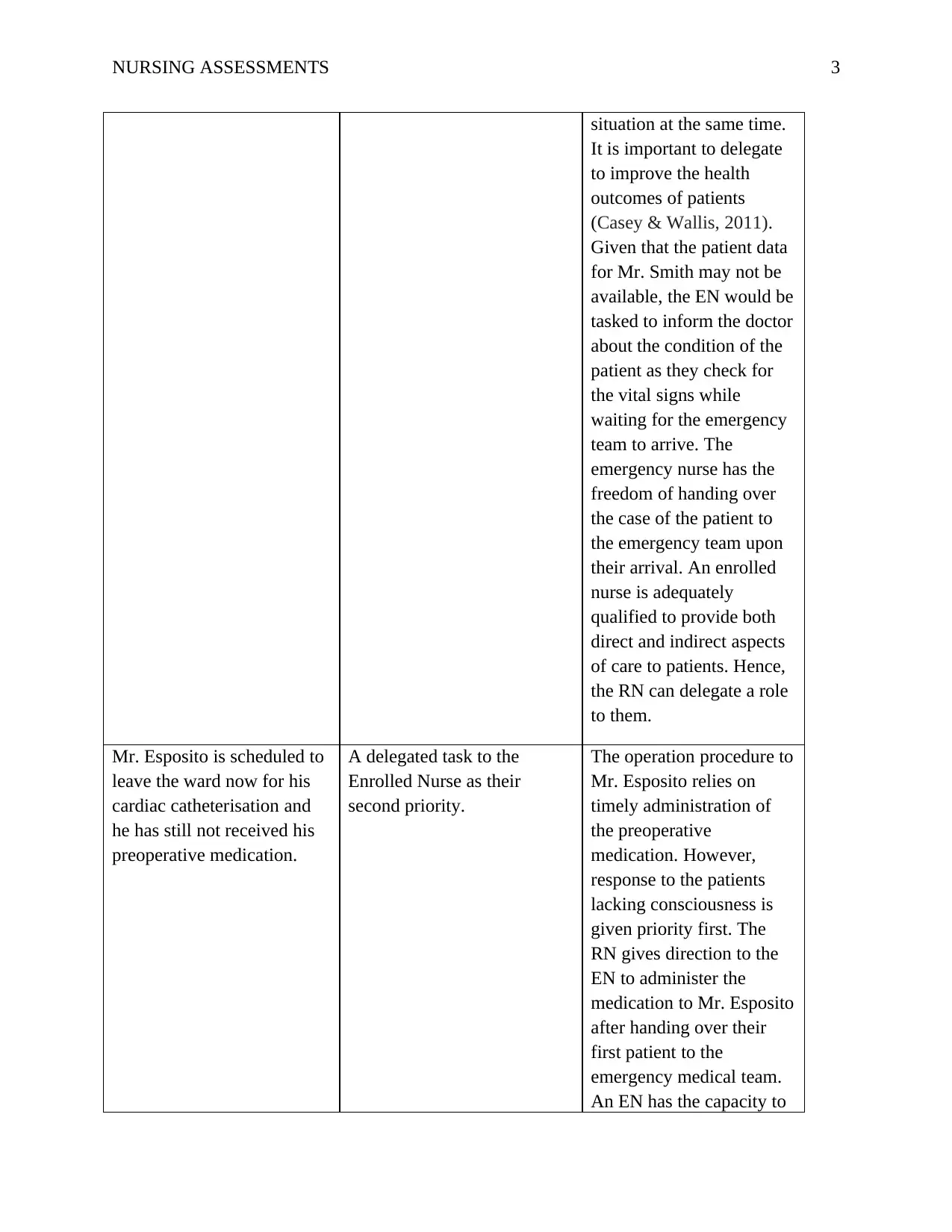
NURSING ASSESSMENTS 3
situation at the same time.
It is important to delegate
to improve the health
outcomes of patients
(Casey & Wallis, 2011).
Given that the patient data
for Mr. Smith may not be
available, the EN would be
tasked to inform the doctor
about the condition of the
patient as they check for
the vital signs while
waiting for the emergency
team to arrive. The
emergency nurse has the
freedom of handing over
the case of the patient to
the emergency team upon
their arrival. An enrolled
nurse is adequately
qualified to provide both
direct and indirect aspects
of care to patients. Hence,
the RN can delegate a role
to them.
Mr. Esposito is scheduled to
leave the ward now for his
cardiac catheterisation and
he has still not received his
preoperative medication.
A delegated task to the
Enrolled Nurse as their
second priority.
The operation procedure to
Mr. Esposito relies on
timely administration of
the preoperative
medication. However,
response to the patients
lacking consciousness is
given priority first. The
RN gives direction to the
EN to administer the
medication to Mr. Esposito
after handing over their
first patient to the
emergency medical team.
An EN has the capacity to
situation at the same time.
It is important to delegate
to improve the health
outcomes of patients
(Casey & Wallis, 2011).
Given that the patient data
for Mr. Smith may not be
available, the EN would be
tasked to inform the doctor
about the condition of the
patient as they check for
the vital signs while
waiting for the emergency
team to arrive. The
emergency nurse has the
freedom of handing over
the case of the patient to
the emergency team upon
their arrival. An enrolled
nurse is adequately
qualified to provide both
direct and indirect aspects
of care to patients. Hence,
the RN can delegate a role
to them.
Mr. Esposito is scheduled to
leave the ward now for his
cardiac catheterisation and
he has still not received his
preoperative medication.
A delegated task to the
Enrolled Nurse as their
second priority.
The operation procedure to
Mr. Esposito relies on
timely administration of
the preoperative
medication. However,
response to the patients
lacking consciousness is
given priority first. The
RN gives direction to the
EN to administer the
medication to Mr. Esposito
after handing over their
first patient to the
emergency medical team.
An EN has the capacity to
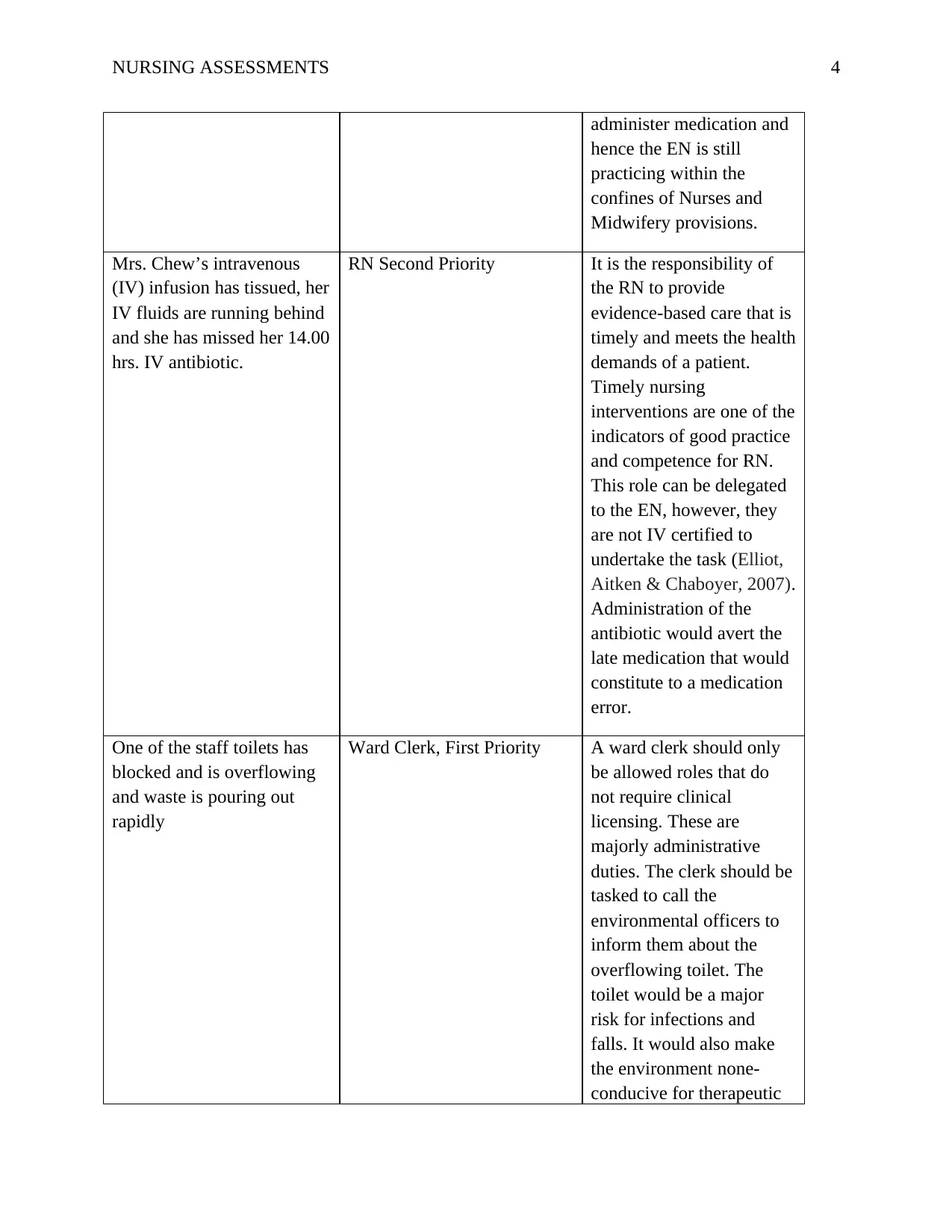
NURSING ASSESSMENTS 4
administer medication and
hence the EN is still
practicing within the
confines of Nurses and
Midwifery provisions.
Mrs. Chew’s intravenous
(IV) infusion has tissued, her
IV fluids are running behind
and she has missed her 14.00
hrs. IV antibiotic.
RN Second Priority It is the responsibility of
the RN to provide
evidence-based care that is
timely and meets the health
demands of a patient.
Timely nursing
interventions are one of the
indicators of good practice
and competence for RN.
This role can be delegated
to the EN, however, they
are not IV certified to
undertake the task (Elliot,
Aitken & Chaboyer, 2007).
Administration of the
antibiotic would avert the
late medication that would
constitute to a medication
error.
One of the staff toilets has
blocked and is overflowing
and waste is pouring out
rapidly
Ward Clerk, First Priority A ward clerk should only
be allowed roles that do
not require clinical
licensing. These are
majorly administrative
duties. The clerk should be
tasked to call the
environmental officers to
inform them about the
overflowing toilet. The
toilet would be a major
risk for infections and
falls. It would also make
the environment none-
conducive for therapeutic
administer medication and
hence the EN is still
practicing within the
confines of Nurses and
Midwifery provisions.
Mrs. Chew’s intravenous
(IV) infusion has tissued, her
IV fluids are running behind
and she has missed her 14.00
hrs. IV antibiotic.
RN Second Priority It is the responsibility of
the RN to provide
evidence-based care that is
timely and meets the health
demands of a patient.
Timely nursing
interventions are one of the
indicators of good practice
and competence for RN.
This role can be delegated
to the EN, however, they
are not IV certified to
undertake the task (Elliot,
Aitken & Chaboyer, 2007).
Administration of the
antibiotic would avert the
late medication that would
constitute to a medication
error.
One of the staff toilets has
blocked and is overflowing
and waste is pouring out
rapidly
Ward Clerk, First Priority A ward clerk should only
be allowed roles that do
not require clinical
licensing. These are
majorly administrative
duties. The clerk should be
tasked to call the
environmental officers to
inform them about the
overflowing toilet. The
toilet would be a major
risk for infections and
falls. It would also make
the environment none-
conducive for therapeutic
Paraphrase This Document
Need a fresh take? Get an instant paraphrase of this document with our AI Paraphraser
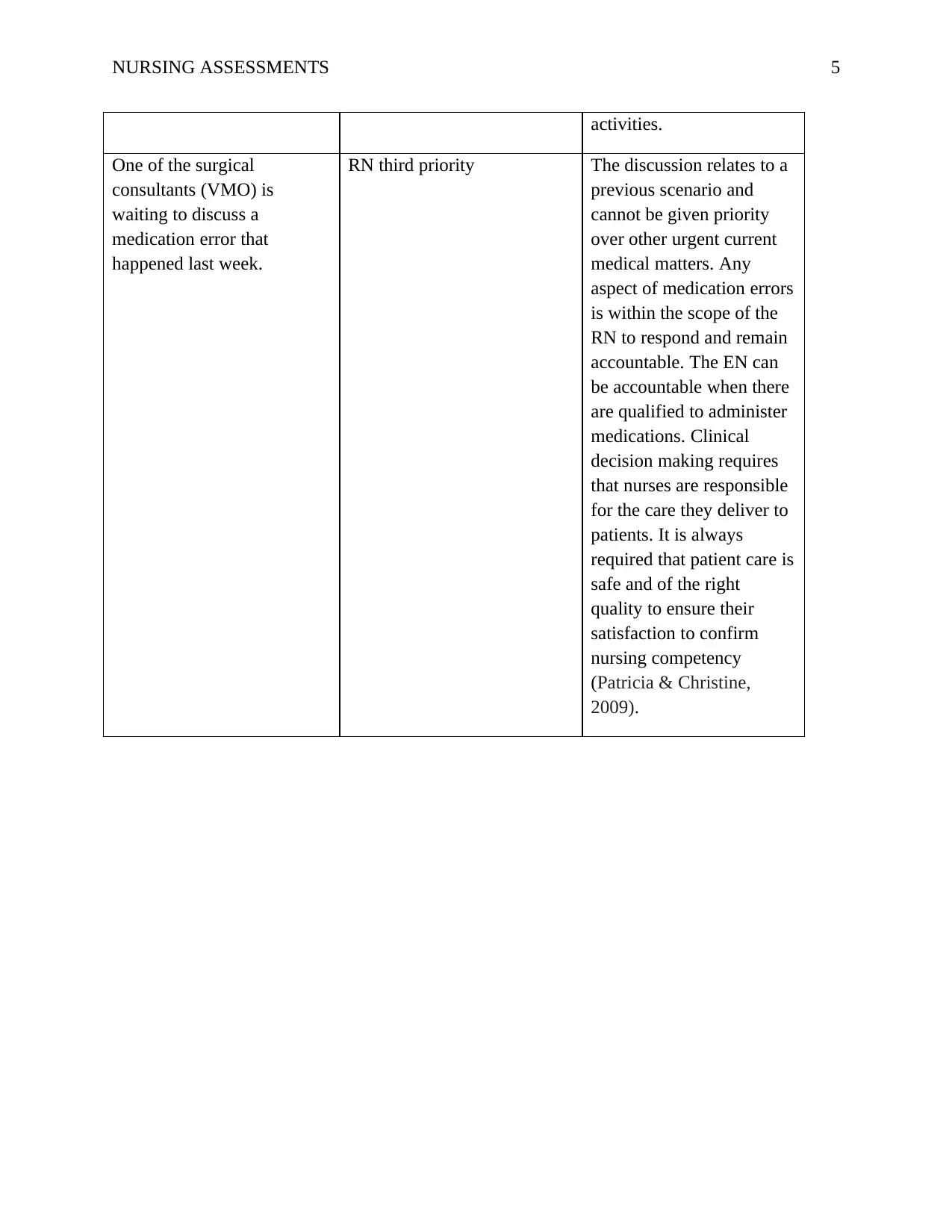
NURSING ASSESSMENTS 5
activities.
One of the surgical
consultants (VMO) is
waiting to discuss a
medication error that
happened last week.
RN third priority The discussion relates to a
previous scenario and
cannot be given priority
over other urgent current
medical matters. Any
aspect of medication errors
is within the scope of the
RN to respond and remain
accountable. The EN can
be accountable when there
are qualified to administer
medications. Clinical
decision making requires
that nurses are responsible
for the care they deliver to
patients. It is always
required that patient care is
safe and of the right
quality to ensure their
satisfaction to confirm
nursing competency
(Patricia & Christine,
2009).
activities.
One of the surgical
consultants (VMO) is
waiting to discuss a
medication error that
happened last week.
RN third priority The discussion relates to a
previous scenario and
cannot be given priority
over other urgent current
medical matters. Any
aspect of medication errors
is within the scope of the
RN to respond and remain
accountable. The EN can
be accountable when there
are qualified to administer
medications. Clinical
decision making requires
that nurses are responsible
for the care they deliver to
patients. It is always
required that patient care is
safe and of the right
quality to ensure their
satisfaction to confirm
nursing competency
(Patricia & Christine,
2009).
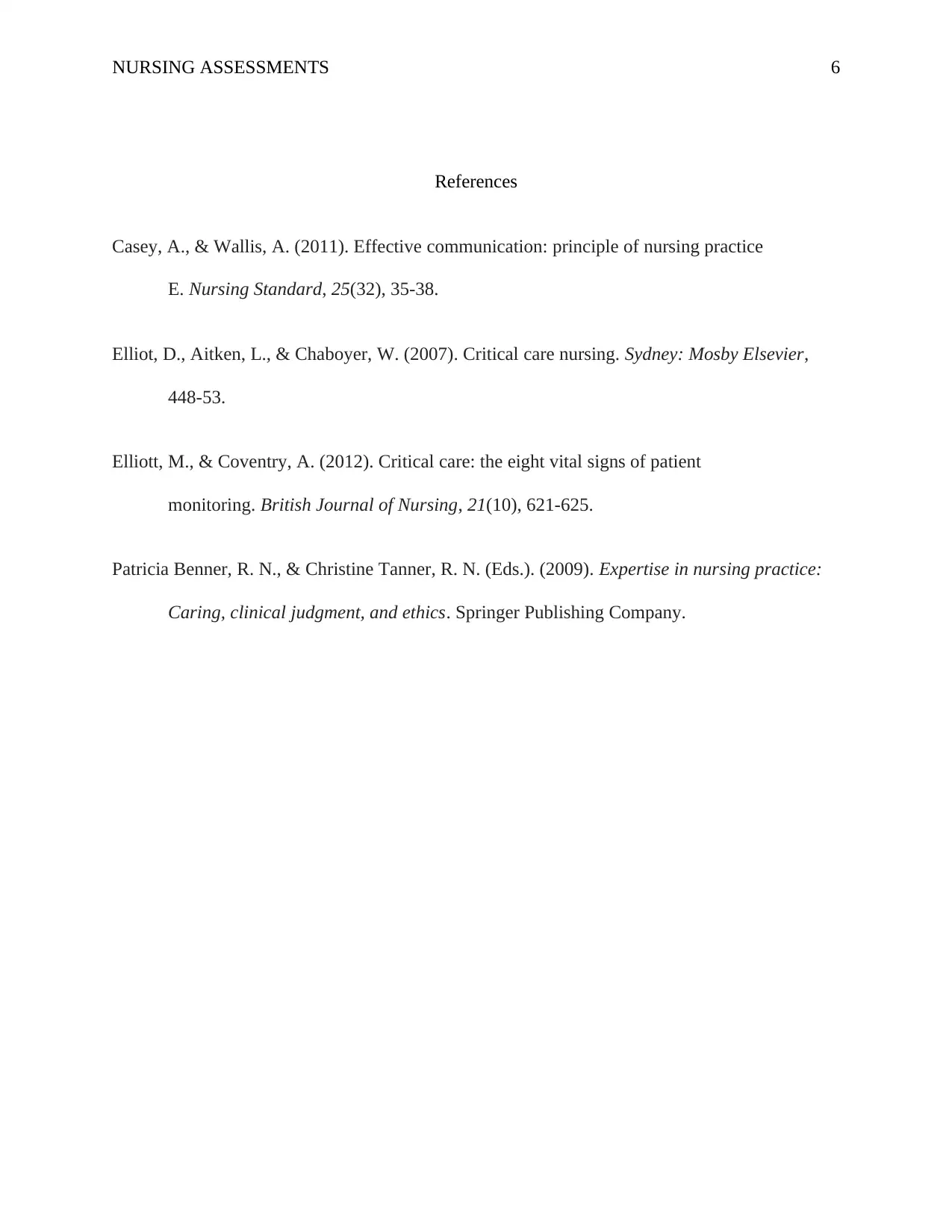
NURSING ASSESSMENTS 6
References
Casey, A., & Wallis, A. (2011). Effective communication: principle of nursing practice
E. Nursing Standard, 25(32), 35-38.
Elliot, D., Aitken, L., & Chaboyer, W. (2007). Critical care nursing. Sydney: Mosby Elsevier,
448-53.
Elliott, M., & Coventry, A. (2012). Critical care: the eight vital signs of patient
monitoring. British Journal of Nursing, 21(10), 621-625.
Patricia Benner, R. N., & Christine Tanner, R. N. (Eds.). (2009). Expertise in nursing practice:
Caring, clinical judgment, and ethics. Springer Publishing Company.
References
Casey, A., & Wallis, A. (2011). Effective communication: principle of nursing practice
E. Nursing Standard, 25(32), 35-38.
Elliot, D., Aitken, L., & Chaboyer, W. (2007). Critical care nursing. Sydney: Mosby Elsevier,
448-53.
Elliott, M., & Coventry, A. (2012). Critical care: the eight vital signs of patient
monitoring. British Journal of Nursing, 21(10), 621-625.
Patricia Benner, R. N., & Christine Tanner, R. N. (Eds.). (2009). Expertise in nursing practice:
Caring, clinical judgment, and ethics. Springer Publishing Company.
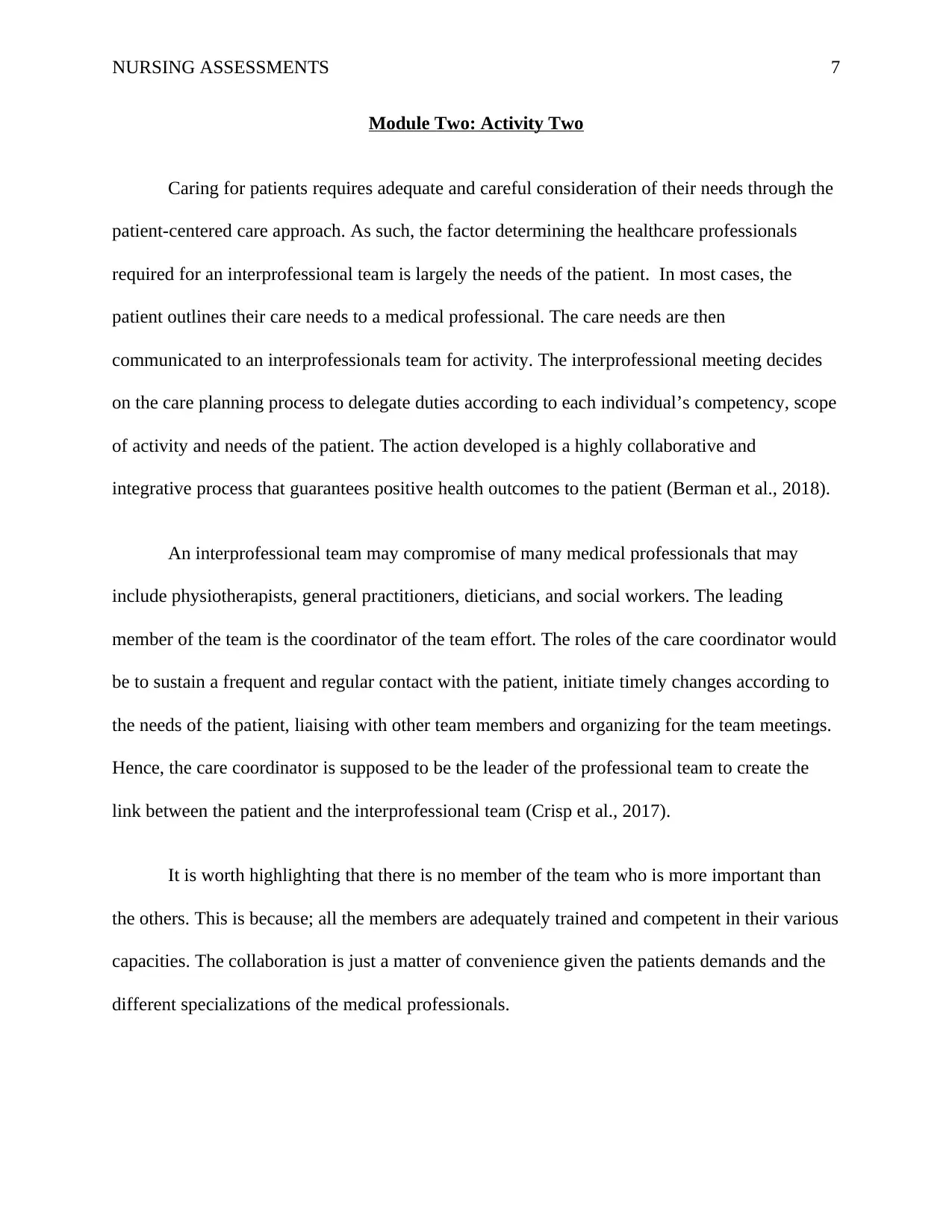
NURSING ASSESSMENTS 7
Module Two: Activity Two
Caring for patients requires adequate and careful consideration of their needs through the
patient-centered care approach. As such, the factor determining the healthcare professionals
required for an interprofessional team is largely the needs of the patient. In most cases, the
patient outlines their care needs to a medical professional. The care needs are then
communicated to an interprofessionals team for activity. The interprofessional meeting decides
on the care planning process to delegate duties according to each individual’s competency, scope
of activity and needs of the patient. The action developed is a highly collaborative and
integrative process that guarantees positive health outcomes to the patient (Berman et al., 2018).
An interprofessional team may compromise of many medical professionals that may
include physiotherapists, general practitioners, dieticians, and social workers. The leading
member of the team is the coordinator of the team effort. The roles of the care coordinator would
be to sustain a frequent and regular contact with the patient, initiate timely changes according to
the needs of the patient, liaising with other team members and organizing for the team meetings.
Hence, the care coordinator is supposed to be the leader of the professional team to create the
link between the patient and the interprofessional team (Crisp et al., 2017).
It is worth highlighting that there is no member of the team who is more important than
the others. This is because; all the members are adequately trained and competent in their various
capacities. The collaboration is just a matter of convenience given the patients demands and the
different specializations of the medical professionals.
Module Two: Activity Two
Caring for patients requires adequate and careful consideration of their needs through the
patient-centered care approach. As such, the factor determining the healthcare professionals
required for an interprofessional team is largely the needs of the patient. In most cases, the
patient outlines their care needs to a medical professional. The care needs are then
communicated to an interprofessionals team for activity. The interprofessional meeting decides
on the care planning process to delegate duties according to each individual’s competency, scope
of activity and needs of the patient. The action developed is a highly collaborative and
integrative process that guarantees positive health outcomes to the patient (Berman et al., 2018).
An interprofessional team may compromise of many medical professionals that may
include physiotherapists, general practitioners, dieticians, and social workers. The leading
member of the team is the coordinator of the team effort. The roles of the care coordinator would
be to sustain a frequent and regular contact with the patient, initiate timely changes according to
the needs of the patient, liaising with other team members and organizing for the team meetings.
Hence, the care coordinator is supposed to be the leader of the professional team to create the
link between the patient and the interprofessional team (Crisp et al., 2017).
It is worth highlighting that there is no member of the team who is more important than
the others. This is because; all the members are adequately trained and competent in their various
capacities. The collaboration is just a matter of convenience given the patients demands and the
different specializations of the medical professionals.
Secure Best Marks with AI Grader
Need help grading? Try our AI Grader for instant feedback on your assignments.
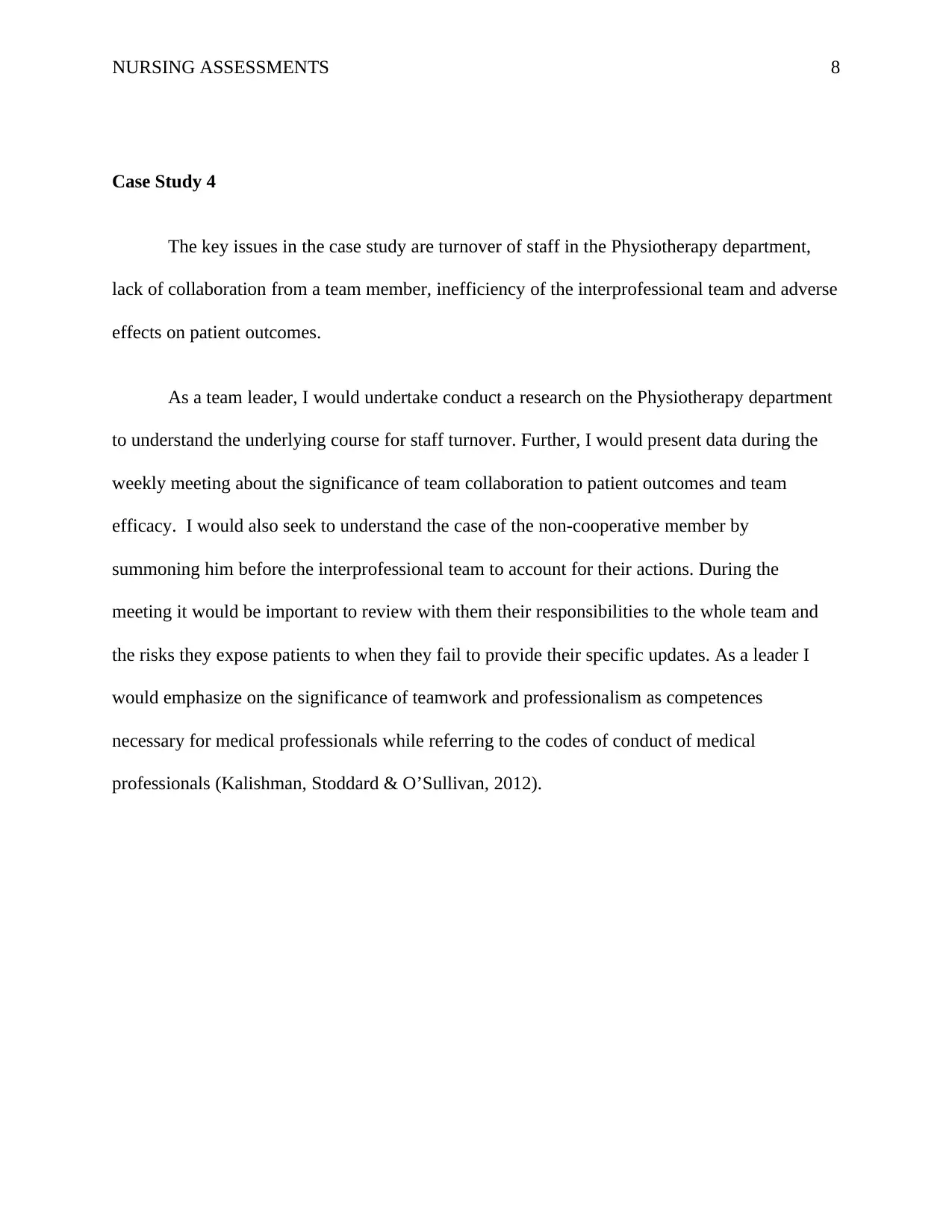
NURSING ASSESSMENTS 8
Case Study 4
The key issues in the case study are turnover of staff in the Physiotherapy department,
lack of collaboration from a team member, inefficiency of the interprofessional team and adverse
effects on patient outcomes.
As a team leader, I would undertake conduct a research on the Physiotherapy department
to understand the underlying course for staff turnover. Further, I would present data during the
weekly meeting about the significance of team collaboration to patient outcomes and team
efficacy. I would also seek to understand the case of the non-cooperative member by
summoning him before the interprofessional team to account for their actions. During the
meeting it would be important to review with them their responsibilities to the whole team and
the risks they expose patients to when they fail to provide their specific updates. As a leader I
would emphasize on the significance of teamwork and professionalism as competences
necessary for medical professionals while referring to the codes of conduct of medical
professionals (Kalishman, Stoddard & O’Sullivan, 2012).
Case Study 4
The key issues in the case study are turnover of staff in the Physiotherapy department,
lack of collaboration from a team member, inefficiency of the interprofessional team and adverse
effects on patient outcomes.
As a team leader, I would undertake conduct a research on the Physiotherapy department
to understand the underlying course for staff turnover. Further, I would present data during the
weekly meeting about the significance of team collaboration to patient outcomes and team
efficacy. I would also seek to understand the case of the non-cooperative member by
summoning him before the interprofessional team to account for their actions. During the
meeting it would be important to review with them their responsibilities to the whole team and
the risks they expose patients to when they fail to provide their specific updates. As a leader I
would emphasize on the significance of teamwork and professionalism as competences
necessary for medical professionals while referring to the codes of conduct of medical
professionals (Kalishman, Stoddard & O’Sullivan, 2012).

NURSING ASSESSMENTS 9
References
Berman, A., Snyder, S., Levett-Jones, T. Dwyer, Hales, M.....Stanley, D. (2018). Kozier and
Erb’s fundamentals of nursing, (4th Australian Ed.).Frenchs Forest, NSW: Pearson.
Crisp, J., Douglas, C., Rebeiro, G. & Waters, D. (2017). Potter and Perry’s fundamentals of
nursing, 5th Ed. Chatswood. NSW: Elsevier.
Kalishman, S., Stoddard, H. & O’Sullivan, P. (2012). Don’t manage the conflict: transform it
through collaboration. Medical Education, 46, 926-934.
References
Berman, A., Snyder, S., Levett-Jones, T. Dwyer, Hales, M.....Stanley, D. (2018). Kozier and
Erb’s fundamentals of nursing, (4th Australian Ed.).Frenchs Forest, NSW: Pearson.
Crisp, J., Douglas, C., Rebeiro, G. & Waters, D. (2017). Potter and Perry’s fundamentals of
nursing, 5th Ed. Chatswood. NSW: Elsevier.
Kalishman, S., Stoddard, H. & O’Sullivan, P. (2012). Don’t manage the conflict: transform it
through collaboration. Medical Education, 46, 926-934.
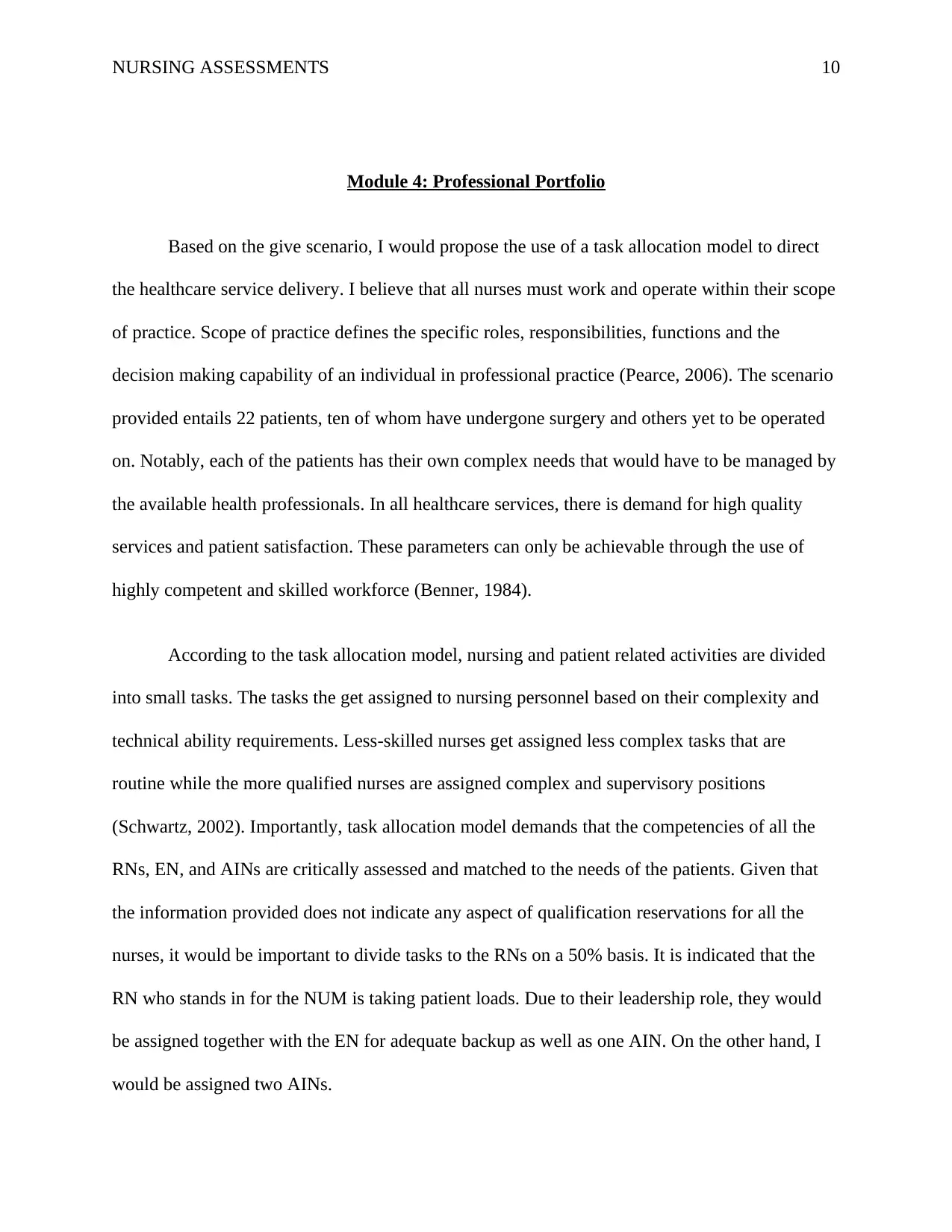
NURSING ASSESSMENTS 10
Module 4: Professional Portfolio
Based on the give scenario, I would propose the use of a task allocation model to direct
the healthcare service delivery. I believe that all nurses must work and operate within their scope
of practice. Scope of practice defines the specific roles, responsibilities, functions and the
decision making capability of an individual in professional practice (Pearce, 2006). The scenario
provided entails 22 patients, ten of whom have undergone surgery and others yet to be operated
on. Notably, each of the patients has their own complex needs that would have to be managed by
the available health professionals. In all healthcare services, there is demand for high quality
services and patient satisfaction. These parameters can only be achievable through the use of
highly competent and skilled workforce (Benner, 1984).
According to the task allocation model, nursing and patient related activities are divided
into small tasks. The tasks the get assigned to nursing personnel based on their complexity and
technical ability requirements. Less-skilled nurses get assigned less complex tasks that are
routine while the more qualified nurses are assigned complex and supervisory positions
(Schwartz, 2002). Importantly, task allocation model demands that the competencies of all the
RNs, EN, and AINs are critically assessed and matched to the needs of the patients. Given that
the information provided does not indicate any aspect of qualification reservations for all the
nurses, it would be important to divide tasks to the RNs on a 50% basis. It is indicated that the
RN who stands in for the NUM is taking patient loads. Due to their leadership role, they would
be assigned together with the EN for adequate backup as well as one AIN. On the other hand, I
would be assigned two AINs.
Module 4: Professional Portfolio
Based on the give scenario, I would propose the use of a task allocation model to direct
the healthcare service delivery. I believe that all nurses must work and operate within their scope
of practice. Scope of practice defines the specific roles, responsibilities, functions and the
decision making capability of an individual in professional practice (Pearce, 2006). The scenario
provided entails 22 patients, ten of whom have undergone surgery and others yet to be operated
on. Notably, each of the patients has their own complex needs that would have to be managed by
the available health professionals. In all healthcare services, there is demand for high quality
services and patient satisfaction. These parameters can only be achievable through the use of
highly competent and skilled workforce (Benner, 1984).
According to the task allocation model, nursing and patient related activities are divided
into small tasks. The tasks the get assigned to nursing personnel based on their complexity and
technical ability requirements. Less-skilled nurses get assigned less complex tasks that are
routine while the more qualified nurses are assigned complex and supervisory positions
(Schwartz, 2002). Importantly, task allocation model demands that the competencies of all the
RNs, EN, and AINs are critically assessed and matched to the needs of the patients. Given that
the information provided does not indicate any aspect of qualification reservations for all the
nurses, it would be important to divide tasks to the RNs on a 50% basis. It is indicated that the
RN who stands in for the NUM is taking patient loads. Due to their leadership role, they would
be assigned together with the EN for adequate backup as well as one AIN. On the other hand, I
would be assigned two AINs.
Paraphrase This Document
Need a fresh take? Get an instant paraphrase of this document with our AI Paraphraser
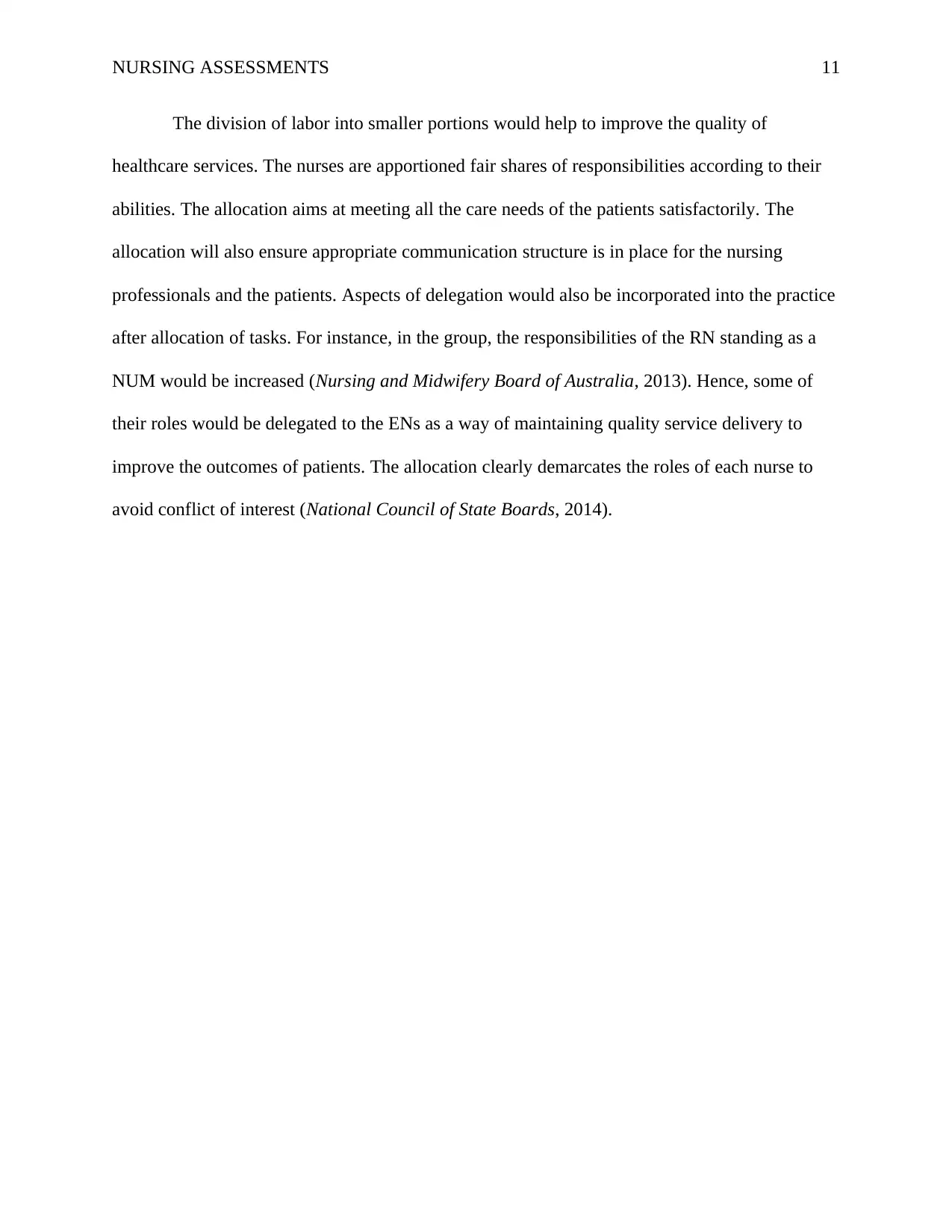
NURSING ASSESSMENTS 11
The division of labor into smaller portions would help to improve the quality of
healthcare services. The nurses are apportioned fair shares of responsibilities according to their
abilities. The allocation aims at meeting all the care needs of the patients satisfactorily. The
allocation will also ensure appropriate communication structure is in place for the nursing
professionals and the patients. Aspects of delegation would also be incorporated into the practice
after allocation of tasks. For instance, in the group, the responsibilities of the RN standing as a
NUM would be increased (Nursing and Midwifery Board of Australia, 2013). Hence, some of
their roles would be delegated to the ENs as a way of maintaining quality service delivery to
improve the outcomes of patients. The allocation clearly demarcates the roles of each nurse to
avoid conflict of interest (National Council of State Boards, 2014).
The division of labor into smaller portions would help to improve the quality of
healthcare services. The nurses are apportioned fair shares of responsibilities according to their
abilities. The allocation aims at meeting all the care needs of the patients satisfactorily. The
allocation will also ensure appropriate communication structure is in place for the nursing
professionals and the patients. Aspects of delegation would also be incorporated into the practice
after allocation of tasks. For instance, in the group, the responsibilities of the RN standing as a
NUM would be increased (Nursing and Midwifery Board of Australia, 2013). Hence, some of
their roles would be delegated to the ENs as a way of maintaining quality service delivery to
improve the outcomes of patients. The allocation clearly demarcates the roles of each nurse to
avoid conflict of interest (National Council of State Boards, 2014).
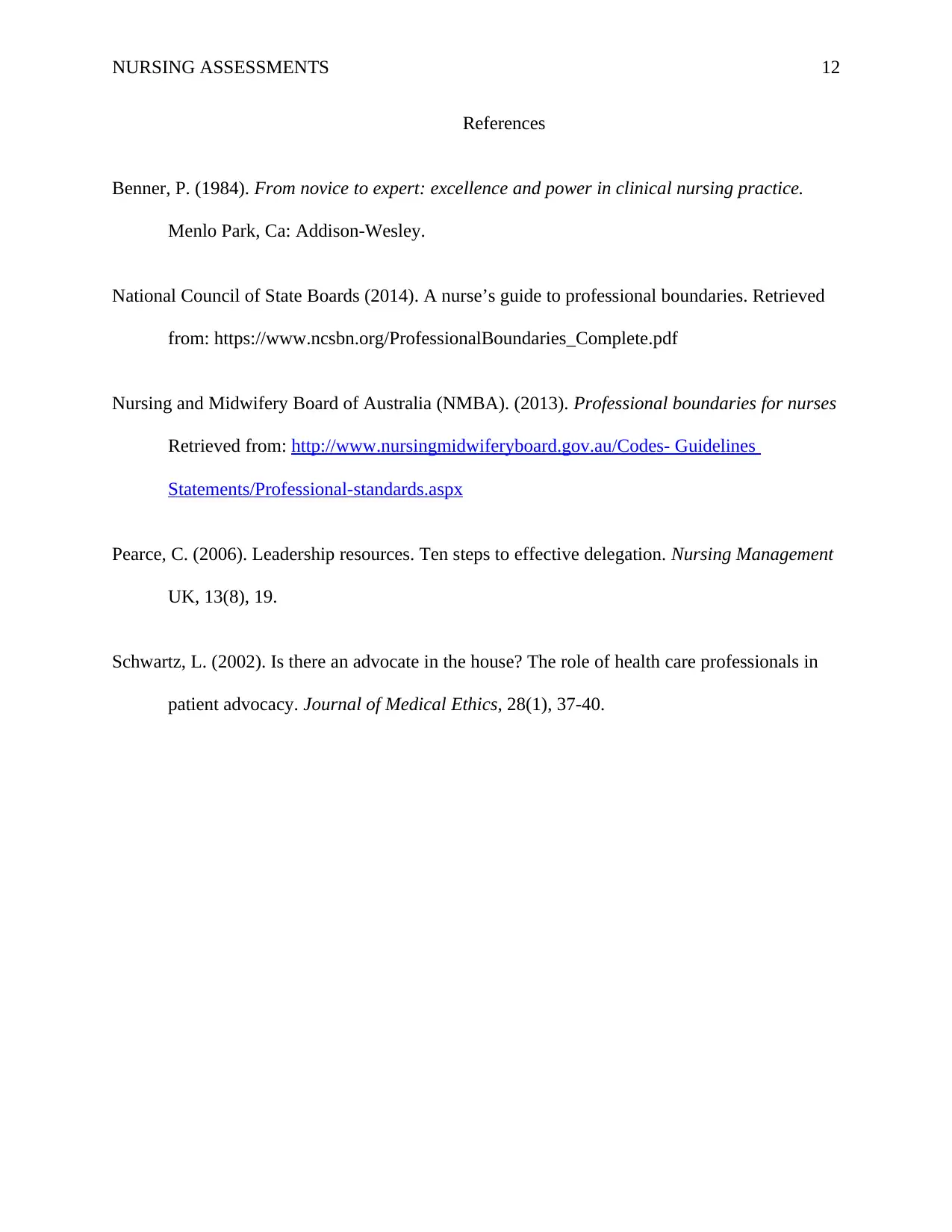
NURSING ASSESSMENTS 12
References
Benner, P. (1984). From novice to expert: excellence and power in clinical nursing practice.
Menlo Park, Ca: Addison-Wesley.
National Council of State Boards (2014). A nurse’s guide to professional boundaries. Retrieved
from: https://www.ncsbn.org/ProfessionalBoundaries_Complete.pdf
Nursing and Midwifery Board of Australia (NMBA). (2013). Professional boundaries for nurses
Retrieved from: http://www.nursingmidwiferyboard.gov.au/Codes- Guidelines
Statements/Professional-standards.aspx
Pearce, C. (2006). Leadership resources. Ten steps to effective delegation. Nursing Management
UK, 13(8), 19.
Schwartz, L. (2002). Is there an advocate in the house? The role of health care professionals in
patient advocacy. Journal of Medical Ethics, 28(1), 37-40.
References
Benner, P. (1984). From novice to expert: excellence and power in clinical nursing practice.
Menlo Park, Ca: Addison-Wesley.
National Council of State Boards (2014). A nurse’s guide to professional boundaries. Retrieved
from: https://www.ncsbn.org/ProfessionalBoundaries_Complete.pdf
Nursing and Midwifery Board of Australia (NMBA). (2013). Professional boundaries for nurses
Retrieved from: http://www.nursingmidwiferyboard.gov.au/Codes- Guidelines
Statements/Professional-standards.aspx
Pearce, C. (2006). Leadership resources. Ten steps to effective delegation. Nursing Management
UK, 13(8), 19.
Schwartz, L. (2002). Is there an advocate in the house? The role of health care professionals in
patient advocacy. Journal of Medical Ethics, 28(1), 37-40.
1 out of 12
![[object Object]](/_next/static/media/star-bottom.7253800d.svg)




